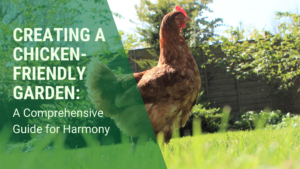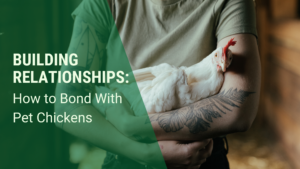Are you a proud owner of chickens, looking to create a harmonious and happy home for all your beloved pets? If so, you’re in the right place! In this blog post, we’ll explore the exciting world of mixing chickens with man’s other best friend, dogs. Learn about how to make sure both your feather and fur babies stay safe and live happily together in our guide. Let’s dive in!
Is it safe to mix chickens with dogs?
This is a common question among pet owners and the answer is yes! It is safe to mix chickens with dogs, as long as certain precautions are taken. Chickens are social animals and can thrive in a multi-pet household, forming bonds with other animals and even displaying protective instincts towards them. The same applies to dogs – many dogs have a natural instinct to protect and care for smaller animals, including chickens. However, it’s important to introduce them properly and ensure their safety.

What to consider before mixing chickens with dogs
First, make sure your chickens have a safe and secure coop and run area where they can retreat if needed. This will provide them with a sense of security and ensure their safety. Additionally, make sure the chickens have plenty of space to roam and forage, as this will help reduce any potential conflicts.
Another consideration is the size and breed of your chickens. Bantam or smaller breeds may be more vulnerable to harm from larger pets, so it’s important to keep this in mind when choosing your flock/dog.
Risks of mixing chickens with dogs
While it is generally safe to mix chickens with dogs, there are a few risks to be aware of. One risk is the spread of diseases. Chickens can carry and transmit diseases such as salmonella and E. coli, which can be passed to dogs (and humans!), so it’s important to practice good biosecurity measures and regularly monitor the health of all your pets.
Another risk is the potential for aggression or predation. Some dogs with prey drives may see chickens as targets, so may chase or attack them. Similarly, some chickens may see dogs as threats and become stressed or aggressive towards them. It’s important to closely supervise their interactions and intervene if necessary.
Assessing Your Dog’s Suitability as a Chicken Companion
When it comes to integrating chickens into a multi-pet household, dog owners need to first consider their canine companion’s temperament and prey drive. It’s important to understand that different dog breeds, as well as individual dogs, may have varying levels of prey drive and behaviour tendencies. Others may be more protective, acting as your livestock guardian!
Breeds with very high prey drives are:
- Greyhound
- Boxer
- Springer Spaniel
- Golden Retriever
- Border Terrier
- English Foxhound
Dog breeds that make particularly good chicken caretakers are:
- Great Pyrenees
- Anatolian Shepherd
- German Shepherd
- Border Collie
- Old English Sheepdog
If your dog tends to get excited or overly curious around small animals, it’s important to consider their behaviour when introducing chickens to the household. Dogs that show a strong prey drive or exhibit extreme interest in birds may cause stress to both the chickens and themselves.
While dogs without a prey drive typically pose no issues to chickens, all dogs react differently to new pets in their territory. Most dogs will adapt to the presence of chickens after an acclimation period, showing initial interest by sniffing the coop or displaying playful behaviour. However, it’s crucial to teach your dog that chickens are fragile creatures and not to be treated as toys or prey.
Training your Dog to Keep Your Chickens Safe

Before making introductions, it’s important to ensure that your dog is well-trained and obedient. Basic commands such as “sit,” “stay,” and “leave it” are essential for everyone’s trust and safety.
You can also work on desensitising your dog to the sight and sound of chickens. This can be done by playing recordings of chicken sounds or showing them videos of chickens. Reward your dog with treats and praise for remaining calm and relaxed during these exercises.
When introducing your dog to chickens, it’s important to start with a dog collar and lead, ensuring a tight fit that prevents slipping but remains comfortable. Walk your dog up to the chicken enclosure while maintaining a tight lead. Observe your dog’s reaction and gradually give more slack and opportunity for positive reinforcement.
Allow your dog to watch you spend time with the chickens from the safety of a walk-in chicken run. If your dog does more than sniff or lingers around the run, take a step back and approach their interaction differently.
The process of fully integrating dogs with chickens may take several weeks. Additional strategies to assist dogs in adjusting to chickens include setting up chicken fencing for observation at a distance, gradually decreasing the distance between the dog’s run or playpen and the chicken run, and rewarding calm behaviour with treats. Always supervise interactions between dogs and chickens, especially initially, as a dog’s excitement or barking can stress the flock.
Tips for a harmonious multi-pet household

Providing separate spaces
While it’s safe for chickens and dogs to coexist, it’s also important to provide separate spaces for them. Chickens should have their own coop and run, where they can feel safe and secure.
Supervised Interactions
Supervision is crucial, especially in the early stages. This allows you to intervene if any aggression or chasing occurs.
Handle aggression quickly and assertively
If you notice any signs of aggression from either your dog or your chickens, it’s important to address it immediately. This can include growling, barking, lunging, or pecking. Separate the animals and consult with a professional trainer or behaviourist if needed.
Training and socialisation
Regular training and socialisation are essential for your dog. This helps them understand boundaries, reduces the risk of aggression, and promotes a harmonious relationship. Enrol your dog in obedience classes or work with a professional trainer to ensure they are well-behaved around your chickens.
Keep both pets well-stimulated
Creating a positive environment for both your dog and your chickens is crucial. Provide plenty of mental and physical stimulation for your dog, such as walks, playtime, and interactive toys. For your chickens, ensure they have a spacious and enriched environment with plenty of room to roam and explore – and plenty of live Black Soldier Fly larvae to keep them busy and stress-free!
Can dogs safely eat Black Soldier Fly larvae?
You may be wondering if you’re feeding these wriggly wonders to your chickens, what would happen if your dog got in on the action? BSF larvae are absolutely safe for dogs – and just as beneficial. In fact, sustainable pet food brand Yora make dog and cat food out of processed Black Soldier Fly larvae! An environmentally friendly protein source with lots of health and animal welfare benefits too! Check them out here.
Fur and feather friends

To successfully introduce chickens into a multi-pet household, such as with dogs, it’s crucial to consider their temperament and behaviour. Take the time to assess your dog’s prey drive and introduce them gradually and with supervision. Prioritise the safety of your chickens by supervising interactions, using leads or enclosures, and rewarding calm behaviour. With patience and proper training, you can cultivate a happy and even loving relationship between your chickens and dogs.
Check out our other articles below for helpful tips and advice on caring for your feathered family.




